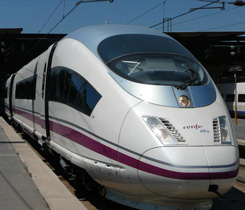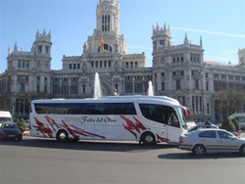BY AIRAs the capital city, Madrid enjoys the best air connections in Spain and operates direct flights to more international destinations than any other Spanish city.
Despite its size Madrid is served by only one airport, Barajas, which recently added a fourth terminal to cope with the constantly growing number of passengers. Barajas may be located 15 km outside the city – but don’t worry: there are various options to reach the centre!
METROA nice and cheap way is to travel by
Metro. Since Madrid’s airport comes with the fact of directly being connected to the public transportation system – why not benefit from it?
Station: Aeropuerto T4 (Terminal 4) and Aeropuerto T1-T2-T3 (other terminals)
Line: L8
Departure Times: ca. 6.00am to 22.00pmL; every 5-15 minutes (
timetable)
Price: ca. 2€ for a single ticket
Travel Time: 12 minutes to the city centre
Important Stop(s): Nuevos Ministerios
AIRPORT EXPRESSWhoever likes to travel with a little more comfort can take advantage of the
Airport Express providing pleasant and spacious travel busses.
Company: Exprés Aeropuerto
Departure Times: 24h a day; every 15 minutes
Price: 5€ for a single ticket
Travel Time: ca. 40 minutes
Important Stop(s): O'Donell, Plaza de Cibeles and Atocha
TAXIIf you are traveling with a lot of luggage, it may be a good idea to choose a taxi to get you directly and exclusively to your exact destination without the struggle of carrying your bags up and down the streets on your own. Just get one of the white caps which can be found in large numbers directly in front of every terminal.
Price: ca. 25€ to get to the city centre
BY TRAINLocated right in the centre of the Iberian Peninsula, Madrid marks the hub for all of the Spanish transportation systems. Therefore it is a natural consequence that especially the traditional train network is very well developed and frequently operates with national as well as international trains. There are two main stations:
ATOCHAIf you are coming into Madrid on the Ave – the famous high-speed train connecting Madrid and Barcelona in 2,5h -, or most other regional services, you’ll almost certainly arrive at Atocha station. Atocha is not just Madrid’s first but also its biggest train station.
Trains: Ave, Elipsos, RENFE, Cercanías, Alvia, Altaria, Alaris
Location: City Centre
Public Transportation Connection: Line 1
CHAMARTINMost international train services, as well as a few regional trains (mainly those coming/going from/to Spain’s north) arrive at the Chamartin station.
Trains: Ave, Alvia, Talgo, Cercanías & international lines
Location: North of Madrid
Public Transportation Connection: Line 1 & Line 10
Keep in mind: To travel between the two main stations, use the RENFE Cercanias train service - it’s a lot quicker than going by metro!
BY COACHThere are many different coach stations in Madrid - but the most important one is the Estación Sur de Autobuses where a lot of national and international buses arrive and departure.
Station: Estación Sur de AutobusesLocation: South of Madrid (a little distant the city centre)
Nearest Metro Station: Méndez Álvaro (Line 6 & RENFE)
BY CARThe most independent way to travel is still by car. Since Madrid is Spain’s capital and a great metropolis in Europe as well, it is a natural consequence that this town provides an excellent connection via freeway.
To find your ideal route check out Spain’s freeway network via
map.
Keep in mind: If you are arriving by car, be aware that the major routes into Madrid are often affected by some form or other of infrastructural work, meaning lane restrictions and long delays. Even without the road works, there are certain times you’ll want to avoid, particularly 7-8am on weekday mornings or Sunday night, when madrileños return from a weekend away. If you are leaving the city, then clearly the evening rush-hour (7-9) and Friday afternoons (offices often close early on a Friday) are best avoided.
PARKINGIf you are not going to use the car during your stay in Madrid and are planning on parking it for a few days, you might want to use one of these parking options:
AIRPORTThere are options on long stay parking at Madrid’s Airport Barajas. You can park you car at special places at every terminal.
Price: ca. 10-30€ a day (depending on your choice of parking-package)
Booking: online reservation available
SERRANO PARKIn the city of Madrid there are three car parks offered by
SerranoPark which provide central and modern garages along the street of Serrano.
Serrano 1: located between Hermanos Bécquer & Marqués de Villamejor
Serrano 2: located between Ortega y Gasset & Hermosilla
Serrano 3: located between Jorge Juan street and the Plaza de la Independencia
Price: max. 27€ a day
Of course, there are numerous other parking options with similar services and prices throughout the whole town. The best way is either to park your car at the airport – if you arrive and departure from there – or to choose an option
close to your apartment.


